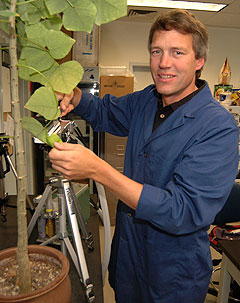Survival of the Fittest or Extinction by Human Progress?
When Charles Darwin wrote "Origin of Species" on an organism's ability to survive and adapt to a changing environment, he could little imagine that man would become an agent of change, altering the environment and impacting the world's ecosystems. More than 100 years after "Origin's" publication, however, Darren Sandquist, associate professor of biological science, has extensive knowledge of what man and his intervention — including the introduction of nonnative species — would bring about. Sandquist has been studying just one such introduction — fountain grass — to the dry forest of Hawaii. Thanks to a $31,500 from the United States Department of Agriculture Forest Service, Sandquist will be able to complete his ongoing studies into the invasion of the African native and its effects on the area. It is believed that the grass was brought to Hawaii in the early 1900s for use as a landscape plant, said Sandquist. It has since taken over the dry side of Hawaii and threatened the native plant populations. "The location is very unique because it harbors many federally listed endangered species," said Sandquist. "This is one of the reasons the study was undertaken. The diversity of the region is even greater than that of the tropical wet forest in Hawaii. "The grass is a phenomenal competitor. In an area with limited rainfall, native plants compete with the grass for the pulses of rain that occur in the area. We think that's a really important source of water for the survival of native plants. The fountain grass seems to use this water source much more efficiently and thereby chocks out the native species," he pointed out. Native plants also face competition for other resources. Nutrient rich lava forms the soil, which is very hard and allows little room for root expansion. The fountain grass thrives in the environment, Sandquist noted. It takes hold and begins to grow rapidly, forming a dense canopy that also deprives native plant seedlings the light they need in order to survive. Perhaps the most severe threat to the ecosystem is that fountain grass ignites easily during fire and quickly spreads the inferno throughout the dry forest, said Sandquist. The grass is able to make a rapid recovery after conflagration but native plant species have no adaptations that enable them to recover from fire. Unfortunately, there is no economically feasible way to get rid the island of the grass, said Sandquist. "Our research has focused on methods that will allow us to promote the regeneration of the forest and establish more of the native species so we can compensate for the negative impact of the alien fountain grass. "We have done an extensive study involving changes in the ecosystem, production and reproduction of native plant species in areas where alien grasses grow, as compared to areas that don't have the weed. As you might expect, we see a dramatic increase in the growth of native species in places that do not have the grass," he said. What was unexpected is that "the growth of the native plants more than compensates for the grass growth prior to it s removal. The trees grow even more biomass, covering a larger area, than where the grass existed." Sandquist Joins Fellow Biologists In Study of Wooly Star Darren Sandquist and Amybeth Cohen, associate professors of biological science, and Eugene Jones, emeritus professor of biological science, are working together on a conservation monitoring program involving the Santa Ana Wooly Star, an endangered species. Their efforts are underwritten by a $136,000 contract from consulting engineering firm PSOMAS. Jones and two other emeriti professors of biological science, Jack Burk and Ted Hanes, initiated the research in 1987. Since then, university scientists have documented the impact that a dam, which was built to control flooding, has had on the rare plant. The wooly star is a low-growing perennial shrub that blooms from June through August. The flowers are bright lavender and tube shaped. This particular species can be found growing along the southwest region of the Santa Ana River from San Bernardino County to Santa Ana Canyon in northeastern Orange County. "The problem with flood control is that there is no longer the scouring effect that removes the non-native species from the area. We are concerned that the plants, which would have normally been eliminated by flooding, will take hold and out compete the wooly star," explained Sandquist. "There is also a question of how much the lack of flooding has affected the distribution of the plant. "I know people may not consider endangered plants as part of their local heritage, but they are. That's the big difference between Hawaii and Southern California. In Hawaii, when we talk about the plant species we are trying to save, most people know about them. When you talk about them here, in California, nobody knows about them," Sandquist observed. "The Santa Ana River basin is part of what I grew up with — it is part of what I connect with when I think of home." As of August 2005, the U.S. Fish and Wildlife Service estimated there were 746 plant species that were either endangered or threatened. |


 Produced by the Office of Public Affairs at California State University, Fullerton.
Contact the
Produced by the Office of Public Affairs at California State University, Fullerton.
Contact the